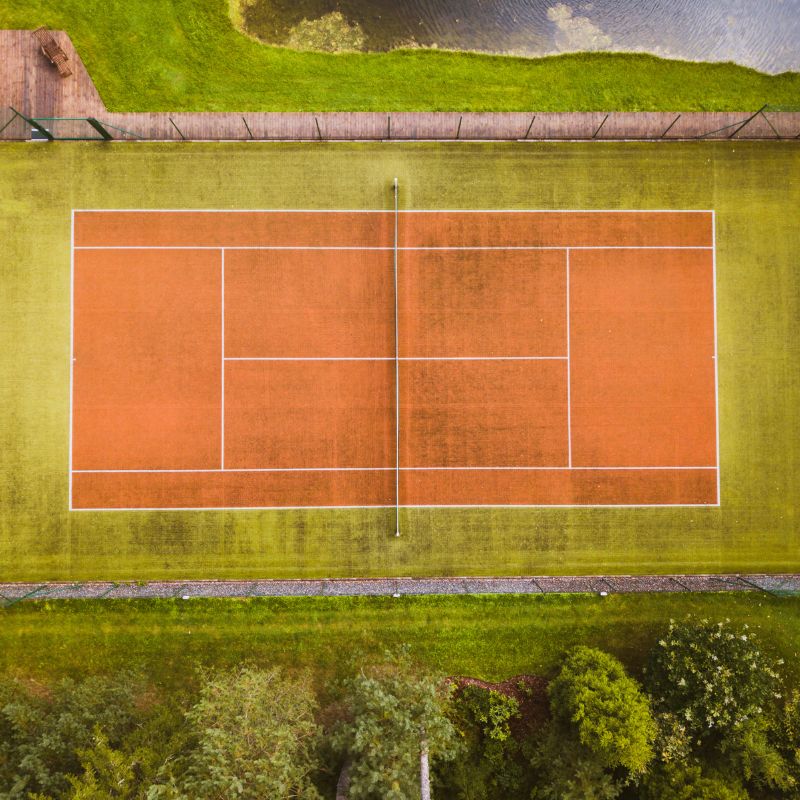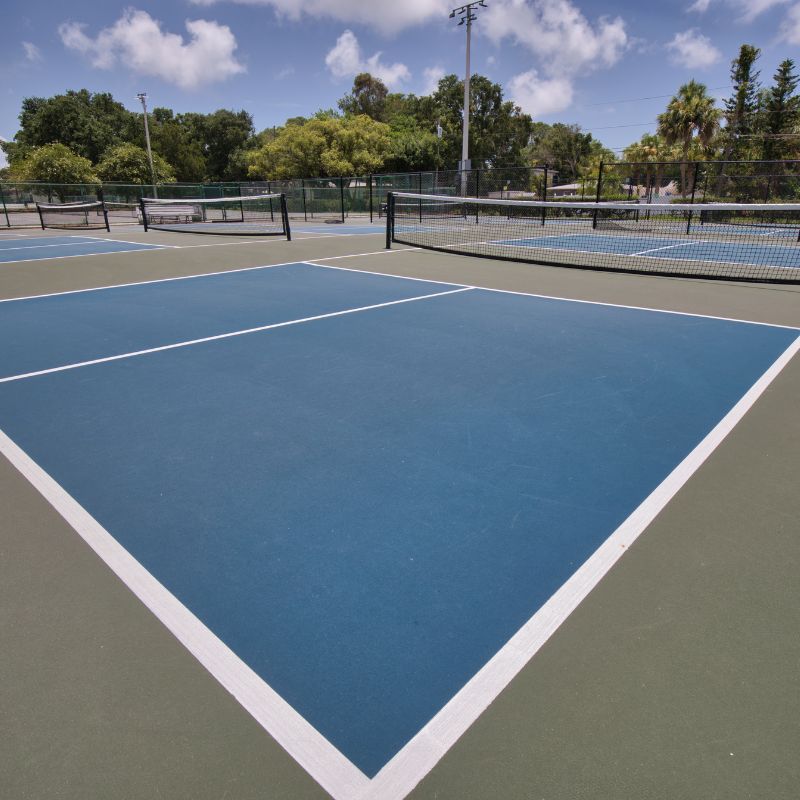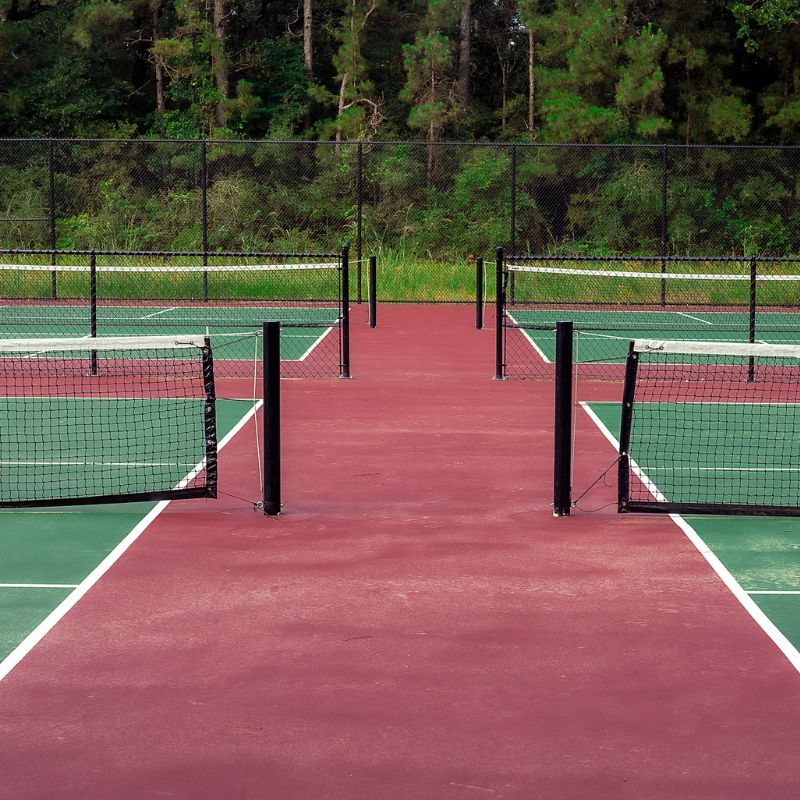Did you know you could convert a tennis court to pickleball? You may have seen multiple lines and a shorter net on a tennis court at your local club or at a public park. The increasing popularity of pickleball has led to more and more pickleball courts being built around the United States. The accessibility, exercise, and social components of the game make it highly addictive.
Tennis court to pickleball conversion poses many advantages—cost efficiency, court size, and accessibility to the game are a few to get behind. Before we dive into the “how-to” of tennis-court-to-pickleball conversion, let’s discuss the reasons why you should convert a tennis court into a pickleball court.
Why Convert a Tennis Court to Pickleball?
Did you catch that subtle flex about converting a tennis court into pickleball courts in the previous sentence? It wasn’t a typo. You can have two pickleball courts on one tennis court.
In fact, you can comfortably fit four pickleball courts on one tennis court.
- More Use: If you’re a club owner, you’ll want to maximize your earnings. You can do this by getting more people to play on your courts, which means converting one tennis court into four pickleball courts really is a no-brainer. While four players can play a match on a tennis court, 16 could play on the same surface area with four pickleball courts.
Perhaps you live in an area with increasing pickleball interest but little court access. One way to gain access to pickleball courts is semi-permanently converting tennis courts to pickleball (with the city’s permission).
Pickleball Court Size vs. Tennis Court: The official size of a pickleball court is 20 feet by 44 feet, with a net that is 36 inches high at the ends and 34 inches high in the middle.
In contrast, a standard tennis court for doubles play is 36 feet by 78 feet, with a net that is 3 feet 6 inches high at the posts and 3 feet high in the middle.
- Cost Efficiency: Tennis court conversion is often more cost-effective than building a new pickleball court from scratch. You already have the playing surface and basic infrastructure. So, all you need are the lines, a portable net, and some pickleball accessories.
- Growing Popularity: As I mentioned above, pickleball is one of the fastest-growing sports in the United States. Converting tennis courts to pickleball reflects the changing demand for recreational sports and provides opportunities to attract a wider range of participants. And I mean a WIDE range.
Did you know one of the top professional women’s doubles teams is a mother-daughter duo? There are a lot of stories like this—a grandfather competing with his grandson, and families of all shapes and sizes coming together to play as a healthy activity.
- Community and Social Benefits: Why is pickleball growing so rapidly? The social aspect is an overwhelming factor. During the COVID-19 pandemic, many people gravitated toward pickleball because of the sport’s social aspect. Not to mention it can be played outside and altered to meet the social distance requirements at the time.
Even after the COVID-19 restrictions were lifted, pickleball’s unique “togetherness” stuck. Converting a tennis court into pickleball courts can foster a sense of community, encouraging active lifestyles.
- Accessibility and Inclusivity: Pickleball is generally considered easier to learn and play for beginners, seniors, and people with mobility issues.
In fact, years of playing tennis led me to a slipped disk, ending my tennis experience earlier than I wanted. Pickleball is slightly different (no overhand serve, smaller court size, and a lightweight paddle—to name a few), and it allowed me to find a new competitive avenue to pursue.
Converting a tennis court into pickleball can make the sport more accessible to ex-collegiate and professional athletes and others.
- Reduced Environmental Impact: Building new sports facilities can have environmental implications like air pollution, noise, and dust, which all come with the use of heavy machinery needed to build the facility. You can reduce the environmental impact associated with new construction by converting existing tennis courts into pickleball courts.
- Versatility: In addition to pickleball, converted courts can also be used for other sports and activities like badminton and basketball.
Cost to Convert Tennis Court to Pickleball
One of the big benefits of converting a tennis court to pickleball is the cost. It’s much cheaper than building a pickleball court from scratch because you already have the location and hard court surface.
Here is an estimate of potential costs, but it’s best to consult a contractor to get the best and most accurate price.
- Line Painting: You’ll need to purchase pickleball-appropriate paint to make the lines. This will cost anywhere from $300 to $800 per court.
- Nets: If you need to install new nets, the cost can range from $100 to $500 per net, depending on the quality.
- Resurfacing: If the tennis court is in poor condition, you may have to resurface it. This can cost anywhere from $4,000 to $8,000. If this is the case, you might want to explore creating your own pickleball court.
- Lighting: If you plan on playing during the night or if you’re running tournaments, it’s best to install lighting. Proper lighting starts around $2,000.
How to Convert a Tennis Court to Pickleball
There are a variety of options when converting a tennis court to pickleball. A single tennis court can be converted into four pickleball courts at most. But there are pros and cons to consider when converting a tennis court to one pickleball court vs. multiple pickleball courts. Let’s review them before we go through a step-by-step guide.
Pros and Cons of Converting One Pickleball Court on a Tennis Court
The main advantage to converting a tennis court into one pickleball court is you’ll have ample room to hit around the post with shots and ernes. Around-the-post shots are hit around the net and into the court, while erne shots are hit by making contact with the ball while you’re in the air and landing outside of the kitchen line. Both shots require room on the side of the court for you to move freely.
| Pros | Cons |
|---|---|
| The conversion process is simpler and less costly, as you only need to repaint the lines. You could even lower the tennis net and use it for pickleball, so you’d save money on purchasing a portable net. | You can only accommodate a limited number of players at a time. The demand for more pickleball courts is increasing as the sport rises in popularity. Adding fewer courts to a viable hitting space seems a bit silly. |
| The players have more space to play, benefiting beginners or those who want to play more casually. |
Pros and Cons of Converting Multiple Pickleball Courts on a Tennis Court
The main advantage of converting four or even two pickleball courts on a tennis court is you’re utilizing the space effectively. More players can have access to experience this great game.
| Pros | Cons |
|---|---|
| This can be a more cost-effective way to serve a larger community of pickleball players. | The conversion process may be more complex and costly, as you’ll need to repaint lines and install additional nets and other equipment like barriers between the courts. |
| It can potentially generate more revenue if you charge for court usage. | The playing area for each court will be smaller, which may not be ideal for competitive play or those who need more space. |
Ultimately, the decision should be based on the needs and preferences of the players who will use the facility, as well as the budget and resources available for the conversion. Speaking for myself, I am a big fan of maximizing the space of the tennis court. I’ve played competitive pickleball games on a tennis court that was converted into four pickleball courts, and I felt like I had enough space to play my best game.
The only disadvantage to playing on a pickleball court surrounded by three other courts is it’s easy for pickleball balls to roll on your court when others are playing around you. It can be distracting and interrupt your pickleball game flow.
How to Convert a Tennis Court to Pickleball
Converting a tennis court into a pickleball court can be an exciting way to diversify the types of sports that can be played on your court. As pickleball has gained popularity over the past few years due to its ease of play and smaller court size, converting a tennis court into a pickleball court is a great option for people of all ages.
Here is a detailed breakdown of the steps you need to take to convert a tennis court into a pickleball court:
Step 1: Measure the Court
Pickleball courts are smaller than tennis courts, so the first step in converting your tennis court is to measure the court and determine where the pickleball lines will go.
A standard pickleball court is 20 feet wide by 44 feet long, including the lines. When setting up multiple pickleball courts on a tennis court. It is important to ensure there is enough space between courts for players to move around.
Step 2: Mark the Court
Once you’ve measured the court, the next step is to use temporary tape or paint to mark the pickleball court lines. You’ll need to be precise when taping or painting lines. Make sure they are accurate and straight, as this will affect gameplay. You may need to use a chalk line or a straight edge to ensure your lines are straight.
Placing tape on the tennis court is a quick but temporary option. If you plan to use tape, be sure to buy tape that you can easily see. Also, it’s important to clean the court surface before placing the tape so it sticks properly and stays in place throughout the gameplay.
If you’re using paint, you’ll still need to clean the court surface but keep in mind you’ll have to wait for the paint to dry before you can play on the court.
Step 3: Adjust the Net
Pickleball nets are hung lower than tennis nets. So you’ll need to adjust the height of the net to accommodate pickleball play. The height of a pickleball net should be 36 inches at the sidelines and 34 inches in the middle.
A standard tennis net is typically 42 inches high. If your tennis net is not adjustable or you’re adding multiple pickleball courts to a tennis court. You’ll need to purchase a portable pickleball net.
Step 4: Add Pickleball Accessories
Once the court is marked and the net is adjusted, add some pickleball accessories to your court. This includes a non-volley zone line (also known as the kitchen line). Which is a line that is 7 feet from the net on both sides. Players are not allowed to volley the ball out of the air in this zone. So make sure it’s marked properly and clearly.
You’ll also need pickleball paddles and balls, which are specifically designed for pickleball play. Not sure what paddles to purchase? Check out this helpful article to discover what paddle is right for you.
Step 5: Start Playing
Once you’ve converted your tennis court to pickleball, you’re ready to start playing. Gather your friends, family, or fellow pickleball enthusiasts and enjoy a game on your new court.
Luckily, pickleball is an easy sport to pick up and is accessible to all levels and ages. It’s a fun, social game that can keep you active so you can keep scratching that competitive itch.
Conclusion
If you have the means and the place to convert a tennis court to pickleball, I highly suggest doing so. But before you’re knee-deep into the process, ask yourself these questions:
- Am I using this for personal use or do I want to make money off of multiple courts?
- If I have access to a set of public tennis courts, do I have permission from the city to convert them?
- Do I want a quick, temporary pickleball court set-up, or do I want a more semi-permanent option?
- What is my budget?
- Would building a pickleball court from scratch be more beneficial than repurposing a tennis court?
Understanding your need and “why” for converting a tennis court into a pickleball court will help you begin the process of building one. Having access to your own pickleball court or a set of pickleball courts can limit wait times for a court. You’ll have all the freedom to play when your personal schedule permits. And the more hitting you put in, the better you’ll become. Happy playing!



































